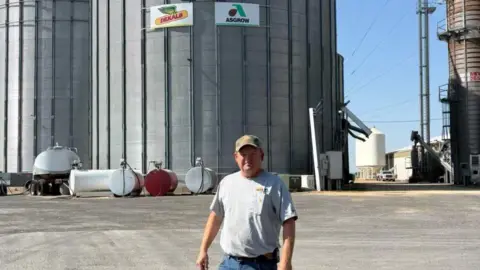Natalie ShermanBusiness reporter and
Danielle KayeBusiness reporter
 Brad Smith
Brad SmithBusinesses across the US have been crying out for months about the damage inflicted by sweeping tariffs President Donald Trump imposed earlier this year.
Now one group is poised to get relief: farmers.
President Trump has said his administration is developing plans to send billions of dollars in support to farmers, especially growers of soybeans, who have been hurt as purchases from China – the world’s biggest buyer of the legume – have dried up this year.
The plan is a reprise of the bailout Trump extended to farmers hit by the trade wars of his first term and reflects pressure he is facing from a key part of his voter base over the consequences of his tariff policies.
But the plans have frustrated many other kinds of businesses that have also been hurt, as the new taxes on imports raise costs for firms based in the US and alienate long-time customers overseas.
“It just seems like a blatant political move,” said Justin Turbeest, a craft brewer in Hudson, Wisconsin, who shut his tap room and laid off 20 staff this summer.
He said tariffs were the final blow for his business, prompting costs to jump roughly 40%, as suppliers of everything from aluminium cans and barley to brand merchandise raised prices.
Mr Turbeest acknowledged that offering wider relief would be impractical, given the vast number of businesses affected.
But the 42-year-old said the discrepancy still stung.
“On a personal level, of course it feels unfair,” he said. “The position we’re in now is due not to normal economic factors. It’s political costs.”
 Justin Turbeest
Justin Turbeest‘Picking winners and losers’
Alexis D’Amato, from the Small Business Majority, said her advocacy group was not opposed to relief, especially for small farms, but felt that small businesses should be included.
“We don’t agree with picking winners and losers in this tariff fight,” she said.
The Trump administration has said it is responding to retaliation from China, after Beijing halted purchases of American soybeans earlier this year.
But other industries, like wine and distilled spirits, have seen sharp drops in exports too.
Wine exports are down 30% this year, according to the California Wine Institute, while exports of distilled spirits to Canada have dropped 85% this year, according to the Distilled Spirits Council of the United States.
Canada recently lifted most of the tariffs it had placed on US goods, but American alcohol remains banned from the shelves in several Canadian provinces.
Distilled Spirits Council president Chris Swonger said he understood the need to provide farmers with relief.
But he added: “Our industry should be included in those considerations.”
Scott Breen, president of the Can Manufacturers Institute, said his organisation was pushing the administration to include an exemption from tariffs for tin plate steel – the metal used for food cans – as part of a farmer relief package, warning that otherwise costs of cans will jump, with ripple effects for farmers.
“One of the best, most direct ways to help them is to give this targeted relief,” he said.
But outside of promising a relief package for farmers, and agreeing to exempt big companies promising investments in the US from tariffs, the Trump administration has shown little concern about the risks of its approach to trade.
Asked by NBC News in May about the possibility of relief for small businesses Trump said: “They’re not going to need it.”
And in recent weeks, he has continued to expand the measures, despite polls indicating relatively limited public support.
During Trump’s first term, China and other trade partners explicitly targeted exports from farmers in an effort to raise political pressure on the president.
But subsequent academic analyses found mixed evidence for the strategy.
While some researchers linked China’s moves to losses by Republicans in the 2018 midterms, others found that bailout payments appeared to help shore up support in farming areas.
Brad Smith, a crop farmer in northwest Illinois, said he welcomed the prospect of relief, after China stopped buying US soybeans in May.
That demand drop led to the price of soybeans sinking to around $10 per bushel, not enough for farmers to break even.
Instead of selling at a loss, Mr Smith is filling his grain storage bins, in the hopes of better prices come spring.
“If you’re swimming in red ink, an infusion of cash helps stem the tide,” he said of the bailout.
How much will the farmer bailout help?
Chris Barrett, an economics professor at Cornell University, said farmers had been “clobbered” by the shifts in trade this year.
But he said he still expected the decision to grant farmers relief to stoke debate, given the agricultural community’s overwhelming political support for Trump and other demands on government funds.
He also noted that US farmers, overall, are no longer poorer than the non-farm population. And during Trump’s first term, research showed that the $28bn bailout in payments for farmers flowed disproportionately to the biggest farms.
“Should we be bailing out those who voted for this, especially if they’re already better off than the average American, and if the bailout funds will be concentrated among the wealthiest of this group?” Prof Barrett asked.
 Mark Legan
Mark LeganMegan Wyatt is the owner of a toy shop in Granite Bay, California, which gets roughly 80% of its products from China. The tariffs mean her costs are 10-15% higher on average this year.
She has not raised prices to fully offset the new expenses, making her concerned about her ability to retain her six employees.
“I’m not upset that other people are getting bailed out,” she said. “I just wish that none of us were in this situation, and I think that we could very easily not be.”
Even in farm country, the bailout is seen as a mixed bag.
Mark Legan, a livestock corn and soybean farmer in Putnam County, Indiana, called the expected government money a “band-aid” that would not address falling crop prices and rising costs for equipment, land and labour.
“I’m not going to fall on the sword and not take the government money,” he said. “But it’s not going to solve the problem.”





